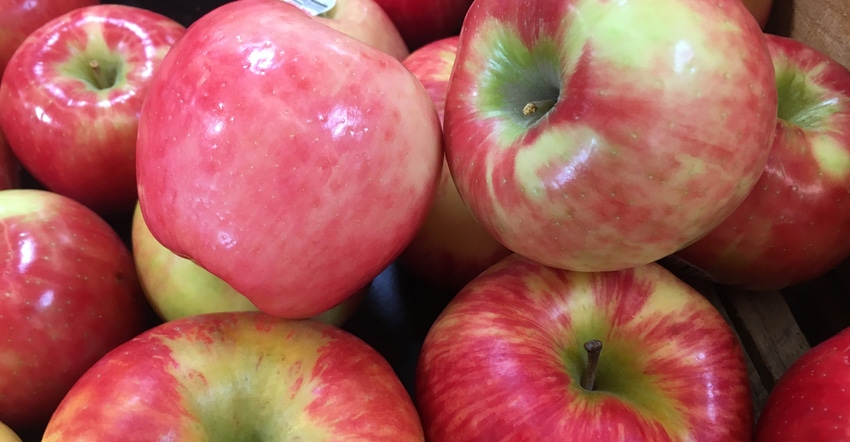September 13, 2018

Just the mention of fall brings a picture of corn harvest, brilliant orange and yellow leaves, and sweatshirts for Friday night football games. And don’t forget those flavorful, seasonal foods that are packed full of nutrition. Pull out the slow cooker. Heat up the oven to bake some bread. Pack a lunch or two for the fields.
It’s time to celebrate anything (and everything) pumpkin, all things pork, and an abundance of crisp, red apples and cranberries. October has the distinction of being National Pork Month, National Cranberry Month and National Apple Month.
National Pork Month was originally started because October was the time most hogs were brought to market. Now, it’s evolved into a way to educate consumers about pork production and the nutritional benefits of eating pork.
October is also the peak month for harvesting cranberries. Cranberries are grown on vines in bogs (those wet, marshy areas). Cranberries are known for their bacteria-blocking compounds that have been linked to urinary tract infections. New research finds these compounds may also be helpful in preventing ulcers and gum disease.
And then there are apples. What says fall better than the crunch of a juicy apple? More than 2,500 apple varieties are grown in the U.S., with new ones added every year. During peak apple season, you can usually find 12 to 18 different varieties of apples in your local grocery store. Each variety is different in size, color, flavor, texture and cooking ability. A few of the more common varieties: Gala, Fuji, Granny Smith, Golden Delicious, Red Delicious, Jonagold, Cripps Pink, Jazz, Braeburn and Honeycrisp.
“Rave is a brand-new variety,” says Ronnie Minteer, produce manager at the Hy-Vee in Springfield, Ill. “It’s part Honeycrisp and part MonArk — an early apple to ripen — that’s juicy and crunchy.”
Many of the varieties are only available for a month or two.
“What we’re seeing is some of the traditional varieties like Empire and McIntosh and Jonathan are being replaced by newer, more popular varieties. More people prefer Jonagold over Jonathan. And Red Delicious is being replaced by Cosmic Crisp,” Minteer says.
Apples are grown in all 50 states, but most apples are grown in Washington, New York and Michigan. Illinois has its share of orchards, but most of the apples grown here are sold at farmers markets or road stands.
Nutritionally, a medium apple has 80 calories and is free of fat, sodium and cholesterol. They are a great source of the fiber pectin and have 5 grams of fiber. It’s best to eat the peel along with the apple — two-thirds of the fiber is in the peel, along with antioxidants, which help reduce damage to cells. Regular apple consumption has also been linked to weight loss, improved gut health, cancer prevention and reduced inflammation, and eating one apple a day helps reduce LDL (bad) cholesterol.
So what to do with apples, besides eat them? Use apple juice instead of water in a spice cake mix, and then add chopped apples for extra flavor. Add apples and pecans to chicken salad. Add chopped apples and a dash of cinnamon to oatmeal before cooking it for a flavorful fall treat. Apples and oatmeal make a great fall combo in bars, cookies and breakfast breads, as well.
Here are a couple of recipes to give you a head start on fall flavors.
Apple Cinnamon Baked Oatmeal
2¾ cups quick oats
¼ cup ground flaxseed
2/3 cup light brown sugar
1 teaspoon cinnamon
¾ teaspoon salt
1 teaspoon baking powder
¼ cup butter, melted
2 eggs
1 cup skim milk
½ cup chopped walnuts
1 apple, diced
¼ cup raisins
In a large bowl, whisk together the oats, flaxseed, brown sugar, salt, baking powder and cinnamon. In a separate bowl, whisk together the melted butter, eggs and milk. Pour the wet ingredients into the dry ones and stir until combined. Gently stir in walnuts, diced apples and raisins. Pour batter in greased 8-by-8-inch baking dish. Bake at 350 degrees F, uncovered, for 20 to 25 minutes. Note: This can be frozen prior to baking if wrapped well; thaw in refrigerator 48 hours prior to cooking. Serves six.
Per serving: 450 calories, 11 grams protein, 62 grams carbohydrate, 20 grams fat, 85 milligrams cholesterol, 7 grams fiber, 430 milligrams sodium
Apple Glazed Roast Pork
2 pounds pork loin roast
3 small apples
¼ cup apple juice
3 tablespoons light brown sugar
1 teaspoon ground ginger
1 teaspoon salt
1 teaspoon pepper
Combine apple juice, brown sugar and ginger together in a small bowl. Rub roast with salt and pepper. Cut apples into four large pieces and place in bottom of slow cooker. Place roast on top of apples and pour apple juice mixture over all. Cover and cook on low for four to six hours. Serves four.
Per serving: 410 calories, 51 grams protein, 28 grams carbohydrate, 9 grams fat, 145 milligrams cholesterol, 3 grams fiber, 115 milligrams sodium.
Fargo is a dietitian for Hy-Vee in Springfield, Ill. Send recipe ideas to her at [email protected].
About the Author(s)
You May Also Like






